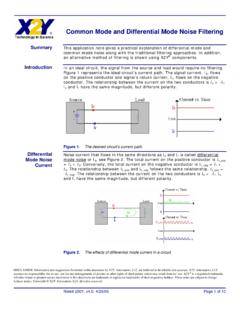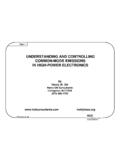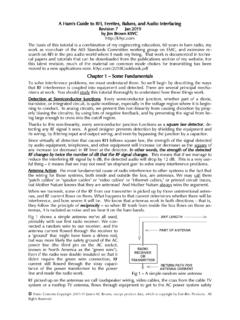Transcription of Common Mode Filter Inductor Analysis
1 Common Mode Filter Inductor AnalysisDocument 200-1 Specifications subject to change without notice. Document 200-1 Revised 11/19/02 AbstractNoise limits set by regulatory agencies make solutionsto Common mode EMI a necessary consideration in themanufacture and use of electronic equipment. Commonmode filters are generally relied upon to suppress lineconducted Common mode interference. When properlydesigned, these filters successfully and reliably reducecommon mode noise . However, successful design ofcommon mode filters requires foresight into the nonidealcharacter of Filter components the Inductor in particu-lar. It is the aim of this paper to provide Filter designersthe knowledge required to identify those characteristicscritical to desired Filter filtering of Common mode noise is typically not aswell understood as its differential counterpart and thispaper deals with the practical aspects of Common modefilters as related specifically to the Common mode in-ductor.
2 Common mode noise occurs simultaneously onboth lines of a conductor pair with respect to a commonground, whereas differential noise occurs between con-ductor paths. The frequency response characteristicsof filters incorporating different Common mode chokeconstructions is examined. The Filter designer shouldthen have a better understanding of Common modeinductors and be able to choose the Common modeinductor construction which will yield the required at-tenuation characteristic without the additional cost ofover-designing or the failure of under-designing the Types of noise and noise SourcesPower converters are often major sources of noise inany equipment. Power converters normally producecommon mode and differential mode noise at harmon-ics of the switching frequency while some wide banddifferential mode noise is usually also emissions from power converters are attrib-utable to a number of causes.
3 The nature of converteroperation (the rectification of the line frequency, andswitching waveforms, for example) and circuit magnet-ics contribute several unique types of noise ; also, thecapacitive effects of components and overall mechani-cal structures, such as cases, and the semiconductorcomponents themselves add their own disruptive volt-ages. An input L-C smoothing Filter is generally requiredin off-line switching regulators, but these inductors andcapacitors may themselves be sources of EMI. If theinductor is constructed with a relatively high Q material,it will display substantial ringing and produce spectralnoise energy. Also, switching noise of the converter maybe coupled back into the line through the distributedcapacitance of the Inductor . The power transformer mayalso ring and couple in ways similar to the Filter inductorand produce its own are semiconductor noise sources associated withtemperature (thermal noise ) within the junction of differ-ing materials (contact noise ) and electron-hole move-ment in junction devices (shot noise ).
4 There exists lowfrequency noise attributable to dc current carrying elec-tronic devices (modulation, flicker, or 1/f noise ), due tothe non-ohmic behavior of semiconductors at high fields(hot carrier noise ), the generation and recombination ofcharge carriers (generation-recombination noise ), andinducted noise at the gate of an FET due to the alter-ation of the source to drain currents by the inducedcharge at the Real vs Observed Filter Frequency ResponseReal filters do not follow the theoretical expectationsprovided by standard Filter alignments (Bessel,Chebyschev and Butterworth See Appendix A). Forexample the expected frequency response of a typicalsecond order low pass Filter is shown in Figure 1. How-ever, due to the self-resonant behavior of Common modeFigure 1. Ideal frequency response predicted for secondorder Filter with Coilcraft E3493 Common modeinductor and F (MHz)Attenuation (dB)10100 Document 200-2 Specifications subject to change without notice.
5 Document 200-2 Revised 11/19/02inductors (and any Inductor ), the observed response isactually similar to that shown in Figure frequencies below resonance, where the Filter com-ponents are nearly ideal, standard Filter configurationsyield very nearly theoretical results. inductors , ideally,provide an impedance which is directly proportional tofrequency, but this is only true for a long, single layer air-core cylindrically wound coil with large gauge wire ( ,the perfect coil).At frequencies above self-resonance, an Inductor be-gins to display the full effects of its parasitic compo-nents, particularly the distributed capacitance (Cd).The Cd describes the effective capacity across an in-ductor and is caused by individual turns of wire in closeproximity (Figure 3). It is the distributed capacitancethat gives the Inductor its characteristic self-resonantfrequency (1LC2 ).
6 Other non-ideal aspects of inductors include leakageinductance, which acts as inductance in series witheach winding. All multiple winding chokes display leak-age inductance. The leakage inductance of a winding isthe amount of inductance which is not coupled to anyother windings through a shared core and is undesir-able in transformers because it stores energy withouttransforming it to other windings in the structure. In alow pass Filter , however, leakage inductance adds to theattenuation of the Filter . In line frequency Common modechokes ( where the differential signal passesunattenuated due to coupling of the winds) the un-coupled leakage inductance will aid in the suppressionof high frequency differential losses such as copper (I2R) and core lossalso affect attenuation. The diameter of wire used in achoke is determined by the amount of current which itwill be required to handle.
7 The larger the current, thelarger the wire. For example, at a line frequency currentof 1 Ampere, 26 AWG wire is required to provide 250circular mils to support the current. As frequency in-creases, the amount of cross sectional area (for a singlestrand of wire) used by the current decreases (skineffect). For frequencies above about 100 kHz, multi-stranded wire (litz wire, with each strand insulated)should be used if the high frequency current is to besupported. For a low pass inductive Filter that needs topass only the line frequencies, further attenuation dueto skin effect is actually exhibit parasitics of their own. For Filter appli-cations, mylar, mica, and ceramic capacitors are themost useful because they exhibit high self-resonantfrequencies due to minimization of their parasitics (se-ries inductance and resistance, and parallel resistance).
8 III. Winding ConfigurationsThree winding configurations for inductors are shown inFigure 4. The most simple and least prone to distributedcapacitance of all the standard configurations is thesingle layer wind. The starts and finishes of a singlelayer wind are as far from one another as possible, thusreducing capacitive coupling. A multilayer wind (two ormore single layers) provides capacitance between lay-ers as well as from the start lead to the finish lead (thatare generally close to one another with the finish leadending where the start lead began). The multilayer (MHz)Attenuation (dB)Figure 2. Measured frequency response of second orderfilter with Coilcraft E3493 Common mode inductorand F 3. Model of an Inductor (one Common modeinductor winding).R-SeriesLCdFigure 4. The tree winding configurations examined134567892 Single Layer1345678921378125611410 92 Double LayerProgressivefiguration displays the greatest capacitance of the wind-ing configurations (thus the lowest attenuation at higherfrequencies for an inductive low pass Filter ).
9 A compromise between the single and multi-layer wind-ing configurations is the third configuration: the pro-gressive (banked) wind. A progressive wind isaccomplished by winding a few turns, then backing up acouple of turns and repeating the process ( three stepsforward and two steps back ). The start and finish leadsare thus as far apart as possible, with the same numberof turns as a multilayer wind, but without the interleav-ing. The distributed capacitance of a progressive wind-ing configuration is between that of a single layer windand a multilayer Real Data and DescriptionIn general, above the self-resonant frequency, chokesbecome largely dissipative, yielding roughly constantand substantial resistance for a very limited frequencyband (a few octaves at most); above this limited band,the chokes become predominately capacitive (Figure 5).
10 The self-resonant frequency of a Filter s Inductor deter-mines the resonant frequency of the Filter itself; maxi-mum attenuation is normally achieved near capacitor (in a second order Filter configuration) de-termines the attenuating behavior of the Filter at frequen-cies above resonance (Figure 6), and with very littlecapacitance, the Filter response exhibits the rapid de-crease of attenuation due to the Inductor response. Alarger value capacitor will increase the slope of attenu-ation after resonance for a limited band of very large Filter capacitor, used to maintain stabilityout to high frequencies, will cause the post resonantattenuation to increase over that achieved at 1 shows the electrical characteristics of one windof each of the Common mode @10kHz (mH)Freq (MHz) to to to to to to to to to to to to to to to to to to to to to 1.








